_________ aims to help students to pay attention to teaching content efficiently at the beginning of the class. A.Lead-in B.Presentation C.Preparation D.Practice
题目
B.Presentation
C.Preparation
D.Practice
相似考题
更多“_________ aims to help students to pay attention to teaching content efficiently at the beginning of the class. ”相关问题
-
第1题:
______ aims to help students to pay attention to teaching contents efficiently at the beginning of the class.A.Lead-in
B. Presentation
C. Preparation
D.Practice答案:A解析:考查教学环节。
本题问的是上课一开始旨在帮助学生注意教学内容,由关键词“at the beginning of the class”可知,应选导入,导入为教学环节的第一步。综上,A选项正确。
B选项,Presentation,呈现新知识环节,故排除。
C选项,Preparation,准备,并非教学环节,故排除。
D选项,Practice,练习环节,故排除。
故正确答案为A项。 -
第2题:
__________method of teaching writing pays great attention to the accuracy of the final product but ignores the process, which the students go through to reach the final goal.A.Form-oriented
B.Product-oriented
C.Content-oriented
D.Process-oriented答案:B解析:考查写作教学。重结果的教学模式对写作最后的成果十分重视,但是却忽视了对写作过程的监控.不利于写作能力的培养。 -
第3题:
When we talk about the element of the teaching aims “ABCD”, what does the “C” refer to?A. content
B.capacity
C. condition
D.competence答案:C解析:本题考查教学设计中的教学目标。
教学设计中提倡用行为目标对学生通过学习后行为及能力的变化进行描述。行为目标的编写方法也叫ABCD模式,即对象(audience)、行为(behavior)、条件(condition)、和标准(degree),也叫行为主体、行为动词、行为条件、表现程度。综上,C选项正确。
故正确答案为C项。 -
第4题:

二、考题解析
【教案】
Teaching Aims:
Knowledge aim: By the end of the class, students will know some expressions of advice and the format of a letter, which includes: an appellation, a body part, a complimentary close and a signature.
Ability aim: Students’ writing ability of letter can be improved by the end of the class.
Emotional aim: Students will be aware of the importance of writing English letter.
Students' interest of learning English can be inspired.
Teaching Key Points:
Students know the format of an English letter and how to make a suggestion.
Teaching Difficult Points:
Students can apply expressions of advice and the format of English letter into their own life.
Teaching Methods:
Communicative teaching method, task-based teaching method, situational teaching method.
Teaching Aids:
PPT, Blackboard and so on
Teaching Procedures:
Step 1: Warming up
1.Greetings
2.Sing an English song We don’t talk anymore, invite the whole students to clap when singing together and lead to the topic.
Step 2: Pre-writing
1.Free talk: Let students talk about the importance of communication in our daily life in group of four, 3 minutes later invite some groups to show their ideas.
2.Set up situation: Let's say our friend Li Ming is very upset recently, because he has a problem in the aspect of communicating with others, we should write a letter to give him some advice.
3.Format: Guide and teach students the format of English letters, which includes: an appellation, a body part, a complimentary close and a signature.
4.Content: Teach students the key sentence structures about how to make a suggestion.(eg: I suggest that you...)
5.Brainstorming: Let students share their ideas about how to communicate with others with their partners, and decide which are the best ideas, make a list of those ideas, then put those ideas into a map so that students can easily see them when they write.
Step 3: While-wirting
Give students some guidance, such as: pay attention to the punctuation, sentence structure, tenses and format. 15 minutes would be given to them to complete their letter within 100 words individually.
Step 4: Post-writing
1.Self-editing: Ask students to check their letter according to the format and sentence structures on the blackboard.
2.Peer editing: Ask students to check and edit their partners’ letter and give them some suggestions.
3.Share: Invite some students to share their letter in front of the class and teacher gives them some comments.
Step 5: Summary & Homework
Summary : Invite a little teacher sum up what we have learned today.
Homework: Let students search more information about how to communicate with others.
 答案:解析:暂无解析
答案:解析:暂无解析 -
第5题:
高中英语?阅读
一、考题回顾

二、考题解析
【教案】
Teaching aims:
Knowledge aim:
Students can know the basic meaning of passage and are able to master the different greeting for the strangers.
Ability aims:
Students can practice guessing content of next paragraph according to the clues which is given in the passage.
Emotional aim:
Students are able to love learning English and like to read different English passage after this lesson.
Key and difficult point:
Key Point: guess the content of next paragraph according to the clues and know the “learned” body language, especially different greetings
Difficult Point: improve students’ reading interest.
Teaching procedures:
Step 1: Warming-up
1. Greetings.
2. Play a video about Chaplin’s mime and ask students several questions:
What kind of body language can you see from this video?
Do you know the meaning of these body language?
Step 2: Pre-reading
Present the passage on the screen and read it for all the students. Before reading, ask students one question: What’s the main ideas of these two paragraphs? And guess the main to topic of this lesson?
Then invite several students to share their ideas.
Step 3: While-reading
1.Lead the students to think one question: Is this a whole passage? And ask students to scan the whole passage and give the teacher answer.
2.Ask students to discuss in group and after 10 minutes to invite several students to share their ideas with all the students.
3.And different students may be just guess the content of several paragraphs. So give students a chart, ask them to finish discussing in 5 minutes. Then invite two representatives to state the whole passage.

Step4: Post-reading
Guessing game: Present another passage on the screen. And give students 10 minutes to read and discuss.Then make a chart and tell your own stories according to chart in your own group .Then invite the representatives to make a report for the whole class.
Step5: Summary and Homework
Summary: ask a student to conclude the content of the lesson and summarize with the whole class.
Homework: Present a passage and ask students to read and write a short passsage,which will be put behind of last paragraph.
Blackboard design:

1.Do you have the experience in teaching?
2. What will you do if you pass this exam?答案:解析:1.
Yes, I do. I have taught a teenager in high school. She was the junior. I mainly taught her grammar. I found her grammar was not very systematic. So I taught her from the grammar in words to the grammar in sentences in order to make her master the whole grammar, especially those always appeared in her exams. And during the teaching, I find the most important that it is the teacher should have a better understanding of the whole grammar and the high school English course. Besides, the teacher should pay more attention to the patience. It will make students relax when their learning and get along with the students.
2.
First, I will find a teaching job to practice my teaching ability. And at the same time to prepare the teachers’ exams for school. When I prepare, I think the most important it’s to know the content of text in high school and do many exercises to practice these knowledge.
Second, I will visit some good teachers who is teaching the high school and learn some experience and practice my teaching ability.
Last, I need to reflect myself to improve my knowledge and my teaching procedures. -
第6题:
初中英语?语音
一、考题回顾
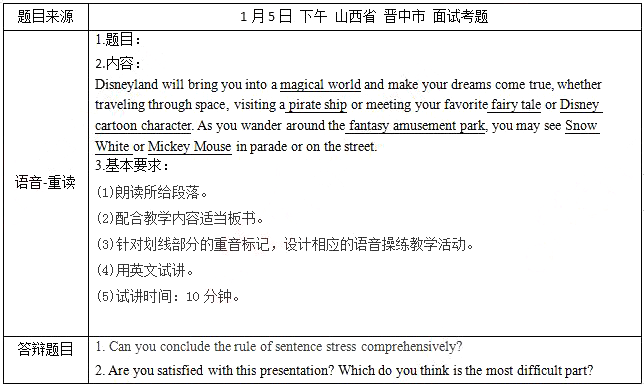
二、考题解析
【教案】
Teaching aims:
Knowledge aim:
Students will know the rule of logical stress in a complete sentence.
Ability aim:
Students will use the logical stress correctly and know how to make use of the sentence stress in different sentences correctly.
Emotional aim:
Students will be more confident in speaking English.
Key and difficult point:
Key Point: Students will master the rule of logical stress in sentences in English.
Difficult Point: Students can use the logical stress in sentences in daily life.
Teaching procedure:
Step 1: Warming-up
1. Greetings.
2. Listen to an English song and feel about the tune of the melody. Let students to know that not only songs but also the language has its stress in order to express different emotions.
Step 2: Presentation
1. Work in pairs to read the passage by themselves and ask them to pay more attention to the sentence stress. After practice, ask one pair to perform it and others should tell their opinion whether they agree or not.
2. Listen to the tape of the passage and find out whether the students themselves make any mistakes. Then let students find out the rule of the sentence stress (logical stress ) with the help of the teacher: in a sentence we can stress the important part according to the meaning of the passage. After the students find the rule, the teacher read the passage and let them repeat after it.
Step 3: Practice
1. Ask students to read the passage by themselves again and they should use the correct logical stress while reading.
2. Give students more sentences and ask them read the sentences by themselves using the logical stress.
Step4: Production
Let students work in groups of 4 and make a dialogue about the theme parks, such as the theme, the feature, the activities and so on, and they should use the rule of logical stress learned in the class. After that invite two groups to share their outcomes with the whole class.
Step5: Summary and Homework
Summary: ask a student to conclude the content of the lesson and summarize with the whole class.
Homework: ask students to read the work of Shakespeare’s and use the logical stress learned today after class.
Blackboard design:

1. Can you conclude the rule of sentence stress comprehensively?
2. Are you satisfied with this presentation? Which do you think is the most difficult part?答案:解析:1.
As far as I’m concerned, there are two sentence stress rules: logical stress and grammatical stress. Logical stress is what i have presented in the presentation. The grammatical stress refers to that we need to stress notional word, which usually contains noun, verb, adjective adverb and so on. At the same time, the functional word needn’t to be stressed, which usually includes conjunction, article and preposition.
2.
The difficulty in my eyes is: first of all, without the participation of students, because of the teaching reasons, I can not interact effectively with students based on their feedback. In this case, it is difficult for me to organize classroom teaching activities and achieve the desired results. Second, what I need to improve is to introduce the key points to the students in a way that is easy to accept and adapt to the environment without an atmosphere of spoken English, because my spoken English is not very fluent, and I am very concerned about this interview. So I felt a little nervous. However, all these factors did not affect my overall performance. In view of the above problems, I will constantly reflect, and learn from experience in practice to improve my teaching ability. In short, I am basically satisfied with the presentation. -
第7题:
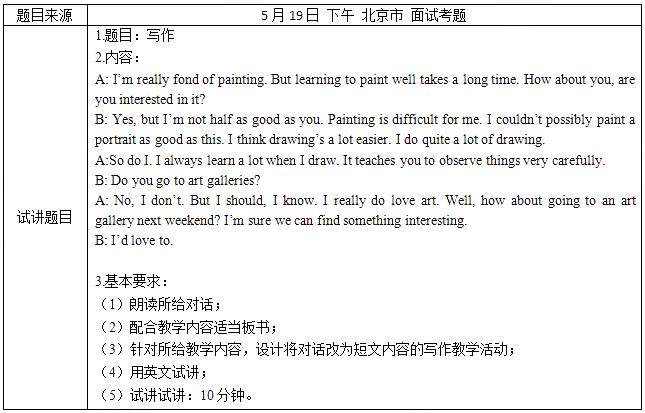
二、考题解析
【教案】
Teaching Aims:
Knowledge aim: Students will master the content about hobbies.
Ability aim: Students can improve their writing ability about hobbies, such as drawing.
Emotional aim: Students will foster a hobby and know how to keep it.
Teaching Key Points:
Students know the content about hobbies and can improve their writing ability about hobbies.
Teaching Difficult Points:题目来源于考生回忆
Students can learn how to write, basing on their hobbies..
Teaching Methods:
Communicative teaching method, task-based teaching method, situational teaching method.
Teaching Aids:
PPT, Blackboard and so on
Teaching Procedures:
Step 1: Warming up
1.Greetings
2. Show two pictures about hobbies , ask all students to observe and describe.
Step 2: Pre-writing题目来源于考生回忆
1. Divide students into two groups, group A and group B and ask them to read the the dialogue.
2. Lead students to summary the main idea.
3.Read the dialogue by themselves again, then ask them some questions to get details.
(1) What are they fond of?
(2) How about drawing, what can it teach you?
(3) Where will they go?
4. Ask students to work in groups and discuss, do a survey on hobbies and reason, collecting key points.
Step 3: While-writing
Students write an article within 20 minutes.
Step 4: Post-writing
1.Self editing: students work in pairs to check if there are faults in spelling and grammar.
2.Sharing: choose 1-2 writing and show it on the screen.
3.Evaluating: appreciate and give comments.题目来源于考生回忆
Step 5: Summary & Homework
Summary : students look at the blackboard and summarize this class.
Homework:students talk about their hobbies to their friends or parents.
Blackboard design:
 答案:解析:暂无解析
答案:解析:暂无解析 -
第8题:
单选题In English teaching, teachers should NOT pay attention to ________.Aproviding independent learning and communicating opportunities for students
Bcorrecting students' mistakes and erors in the process of learning immediately
Cencouraging students to discuss, cooperate, experience, practice, and explore the way to master English
Dcultivating students' interest
正确答案: B解析: -
第9题:
单选题During class, the teacher leads students to memorize the important points of the teaching content. On one hand, the teacher helps students to grasp the key points. On the other hand, what learning strategy is the teacher teaching?ACognitive strategy.
BSelf-management strategy.
CCommunication strategy.
DResource strategy.
正确答案: B解析: -
第10题:
单选题The teacher would use to help students communicate in teaching speaking.Asubstitution drills
Bgroup discussion
Clistening and acting
Dreading aloud
正确答案: A解析: -
第11题:
单选题After teaching sounds, a teacher makes a test that aims to find out which sounds students are not able to pronounce. This test belongs to_________Aaptitude test
Bproficiency test
Cachievement test
Ddiagnostic test
正确答案: C解析: -
第12题:
单选题____ aims to help students to pay attention to teaching content efficiently at the beginning of the class.ALead-in
BPresentation
CPreparation
DPractice
正确答案: B解析: -
第13题:
During class, the teacher leads students to memorize the important points of the teaching content. On one hand, the teacher helps students to grasp the key points. On the other hand, what learning strategy is the teacher teaching?A.Cognitive strategy
B.Self-management strategy
C.Communication strategy
D.Resource strategy答案:A解析:本题考查英语学习策略
A选项,老师在教学中引导学生对教学要点进行记忆,一方面是为了让学生了解课程内容的重点,另一方面是为了传授学生学习策略,而在学习中记住要点是属于学习策略中的认知策略。综上,A选项正确。
B选项,自我管理策略,故排除。
C选项,交际策略 ,故排除。
D选项,资源策略 ,故排除。
故正确答案为A 项。 -
第14题:
______ aims to help students to pay attention to teaching contents efficiently at the beginning of the class.A.Lead-in
B.Presentation
C.Preparation
D.Practice答案:A解析:考查教学环节。
本题问的是上课一开始旨在帮助学生注意教学内容,由关键词“at the beginning of the class”可知,应选导入,导入为教学环节的第一步。综上,A选项正确。
B选项,Presentation,呈现新知识环节,故排除。
C选项,Preparation,准备,并非教学环节,故排除。
D选项,Practice,练习环节,故排除。
故正确答案为A项。 -
第15题:

二、考题解析
【教案】
Teaching aims:
Knowledge aim:
Students can express their opinion and give others solutions on the topic.
Ability aim:
Students can develop their logical thinking ability through writing.
Emotional aim:
Students will know how to get along with their parents and then love and cherish their family.
Key and difficult point:
Key Point: Students make clear about how to give others suggestions. .
Difficult Point: Students can understanding the deep meaning of family.
Teaching procedure:
Step 1: Warming-up
1. Greetings.
2. Sing a song : Five Hundred Miles, then ask students the theme of the song, if they don’t know, the teacher will tell them that the song is used to express the feeling of wandering one missing his families.
Step 2: Pre-writing
1. The teacher read the letter to students and let students pay attention to the feeling of the author.
2. Brainstorming: tell students they should write a letter to the author, and what they should do is to have a discussion on the topic what the author should do to get along with her parents, and they are supposed to give as many suggestions as possible.
3. Then invite some students to write down their ideas on the blackboard.
4. Analysis the format of letter briefly.
Step 3: While-writing
Drafting: According to the analysis above, give students 15 minutes to write a letter to the author. First, remind them of the preparations we made during pre-writing. Secondly, go into them and give them some instructions when they are writing and ask them pay attention to grammar, punctuation, spelling and so on.
Step4: Post-writing
1. Peer editing: After the drafting, ask students to check the ideas or the logical development. Pay attention to the grammar, spelling and punctuation of their writings.
2. Sample show: choose several passages for them to learn and give them some evaluations from the advantages and disadvantages.Then ask them to rectify their own writings according the evaluations.
Step5: Summary and Homework
Summary: ask a student to conclude the content of the lesson and summarize with the whole class.
Homework: ask students to talk about their own problems honestly with their parents and try to solve them together.
Blackboard design:

1. Please talk about the principles of teaching writing?
2. What’s your favorite book?答案:解析:1.
There are several principles in writing: appropriate approaches; integration principle; communicative principle; realistic principle; procedural principle.
2.
Among all the books I have read, A Dream of Red Mansions, one of the four great works in China, an encyclopedia of the ancient Chinese life, is my favorite. What attracts me most in this book are the fabulous communication skills, which provokes me with great inspiration. Take Baochai for instance, though she was nice and considerate to everyone, when she was attacked by ridicules, she would fight back forcefully without hesitation. And her retort was always sparkling with wisdom, which I appreciate so much, and which I believe is indispensable in daily work. I believe that when we are challenged by some sharp questions, we should take Baochai as an example to make a tactful reply. -
第16题:

二、考题解析
【教案】
Teaching aims:
Knowledge aim: Students can understand the pronunciation of “ear”, and get some simple spelling rules.
Ability aim: Students can read the words with the pronunciation of “ear” correctly by listening and speaking. Ability of listening and speaking will be improved.
Emotional aim: Students can increase their interests in learning English.
Key and difficult point:
Key points: Students can understand the pronunciation of “ear”, and how how to read the words contain “ear”, such as hear, near and etc.
Difficult points: Students can master the pronunciation of “ear” and read the related words correctly.
Teaching procedure:
Step 1: Warming-up
Greeting the students.
Sing a song: Head shoulder keens and toes.
Step 2: Presentation
1. Show the chant and ask the students the question: Can you find the same letter combination in these words?
2. Listen to the tape and let students pay attention to the pronunciation of “ear”, and then ask the students question: what does “ear” sounds like in these words?
3. Teacher the pronunciation of “ear” ,and let students pay attention to the teacher’s mouth.
4. Game: Play the finger show to practice the new words.
Step 3: Practice
Find more words with “ear” such as tear, dear, clear... and ask students to try to read by themselves and then invite some of them to share with the class. The teacher should act the role of monitor.
Step4: Production
1. Ask students to make up their own sentences by using the words learned today, such as “He hears the bad news,and then his tears falls down. ”.
2. Reading competition: let students to read the chant as quickly as possible, and then let students choose the best one.
Step5: Summary and homework
1. Summary: ask students summary what have learned in the class.
2. Homework:
(1) read these word after class.
(2) Find more words with “ear” and make another chant.
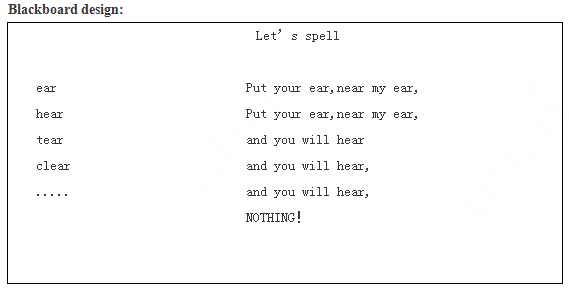 答案:解析:暂无解析
答案:解析:暂无解析 -
第17题:

二、考题解析
【教案】
Teaching Aims:
Knowledge aim: Students will master the content about hobbies.
Ability aim: Students can improve their writing ability about hobbies, such as drawing.
Emotional aim: Students will foster a hobby and know how to keep it.
Teaching Key Points:
Students know the content about hobbies and can improve their writing ability about hobbies.
Teaching Difficult Points:
Students can learn how to write, basing on their hobbies..
Teaching Methods:
Communicative teaching method, task-based teaching method, situational teaching method.
Teaching Aids:
PPT, Blackboard and so on
Teaching Procedures:
Step 1: Warming up
1.Greetings
2. Show two pictures about hobbies , ask all students to observe and describe.
Step 2: Pre-writing
1. Divide students into two groups, group A and group B and ask them to read the the dialogue.
2. Lead students to summary the main idea.
3.Read the dialogue by themselves again, then ask them some questions to get details.
(1) What are they fond of?
(2) How about drawing, what can it teach you?
(3) Where will they go?
4. Ask students to work in groups and discuss, do a survey on hobbies and reason, collecting key points.
Step 3: While-writing
Students write an article within 20 minutes.
Step 4: Post-writing
1.Self editing: students work in pairs to check if there are faults in spelling and grammar.
2.Sharing: choose 1-2 writing and show it on the screen.
3.Evaluating: appreciate and give comments.
Step 5: Summary & Homework
Summary : students look at the blackboard and summarize this class.
Homework:students talk about their hobbies to their friends or parents.
Blackboard design:
 答案:解析:暂无解析
答案:解析:暂无解析 -
第18题:
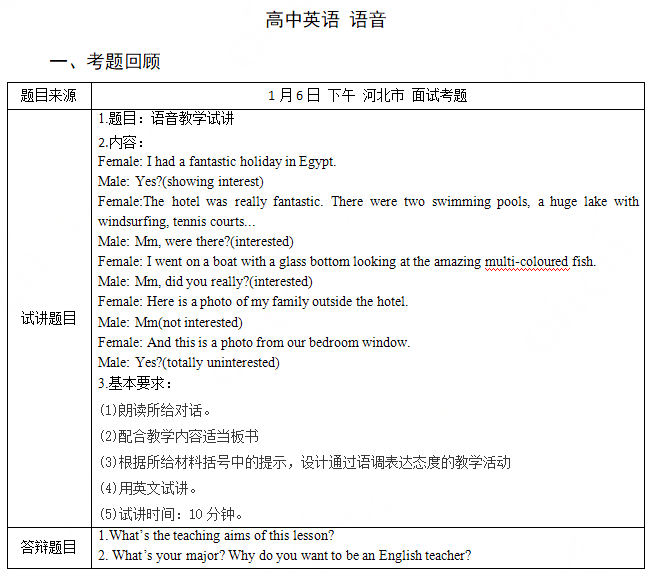
二、考题解析
【教案】
Teaching aims:
Knowledge aim:
Students can master the intonation of showing their attitudes.
Ability aim:
After this lesson, students can practice their listening and speaking ability through group work.
Emotional aim:
Students are able to love learning English after this lesson.
Key and difficult point:
Key Point: master the intonation of showing their attitudes.
Difficult Point: cultivate the interest of students’ learning English.
Teaching procedures:
Step 1: Warming-up
1. Greetings.
2. Play a video about a person who is shopping at a store and has a conversation with the shop assistant. And ask students to answer some questions: Does this customer want to buy the clothes? Give the reason
Step 2: Presentation
1.Ask students to listen the conversation carefully and the teacher reads the conversation that today needs to learn and ask students:
Which part does the male show the interest? Give the reason
And which part does the male show the uninterested? Give the reason
2.Then present the conversation on the PPT, and ask students to listen to the conversation again, pay attention to the intonation of male’s answers. And ask students to answer some questions:
When male shows the interest to the content of female’s saying, what kind of intonation does he use? Uninterested, what’s intonation?
3. Then lead the students to conclude the rules of intonations of showing their attitudes. At the same time, write the male’s words on the blackboard with the help of symbols of rising tone and falling tone.
Step 3: Practice
1.Ask students to read this conversation after the tape.
2.Role-play: Ask students to practice this conversation with their partner and after 5 minutes, invite some students to read this conversation for all the students.
3. Dubbing: Ask students to look at a short video about a conversation between a Chinese student and another foreign student. But this video only has the frames, but doesn’t have the sound, which needs students to finish dubbing with their deskmates in given 10 minutes. Then invite several students to show their conversation with all the students.
Step4: Production
Make stories: Ask students to use the knowledge of intonation to make a short story according to the chart. Before this, divide the students into several groups with different persons and ask the representatives to get their topic through the way of random draw.
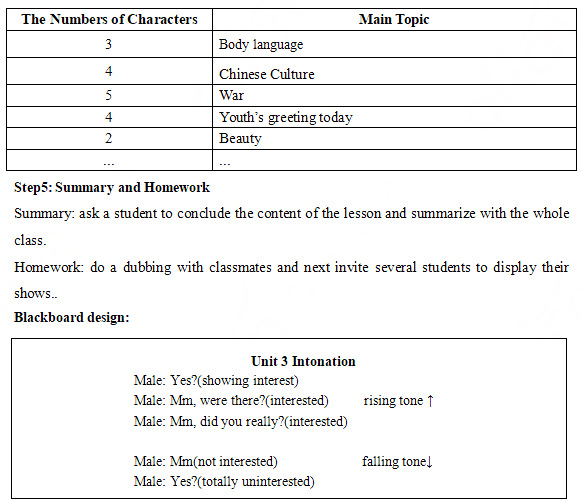
1.What’s the teaching aims of this lesson?
2. What’s your major? Why do you want to be an English teacher?答案:解析:1.
There are three aims: knowledge aim,ability aim and emotional aim.
Knowledge aim:
Students can master the intonation of showing their attitudes.
Ability aim:
After this lesson, students can practice their listening and speaking ability through group work.
Emotional aim:
Students are able to love learning English after this lesson.
2.
My major is medicine. But I like English. And my biggest hobby is learning and speaking English. In my daily life, I like to go abroad to travel and reading English novels. I think English is more useful and attracting for me than my major, medicine. -
第19题:
一、标题不可缺少
What are you doing?
二、教学目标撰写要以学生为主语
Teaching aims:
(1) Knowledge aims
Students can master the key sentence structure “what are you doing?” .
(2) Ability aims
Students can communicate with their partners by using the new sentence.
(3)Emotional aims
Students will be more interested in sharing their ideas with others and take part the group activity.
Teaching key point
Master the new sentence structure.
Teaching difficult point
Describe what other people are doing.
Teaching Methods:
Situational teaching method, task-based teaching method
Teaching Aids:
PPT
三、教学过程要完成清晰
Teaching procedure
Step 1 Warming-up
At the beginning of class, ask students a question about what do they usually do on weekend. Students may have different answer like go to the zoo, stay at home and so on. Then teacher ask: “do you want to know what others are doing now?” to lead to the topic today, and write it down on the blackboard.
(step can give students chances to speak English ,and get a good preparation for the next step—the presentation part, student’s interest will be aroused as they can share the things they know with others in English. It can also help nurture students’ confidence.)
Step 2 Pre-reading
Show the picture about the Larry’s home, letting students guessing what happened and predict the content about the reading material.
(Justification: guessing part will focus students’ attention on the main topic of the reading passage. It prepares students to think critically about the topic and provides them with the opportunity to connect some aspect of the topic to their own lives)
Step3while-reading
Fast-reading
Ask students to read the short passage quickly and conclude the main idea.
(Justification: train students’ reading ability of scanning for the general information of the passage.)
Careful reading
1.ask students to read the passage again and answer the following questions:
What is Larry doing?
What is dad doing?
What’s grandpa doing?
2. Ask students to finish the sentence on the textbook.
(Justification: in this part, students’ analyzing and summarizing ability can be trained. In the process of answering, students can get the detailed information, which can help students understand the sentence.)
Step4 post-reading
1.play the tape and ask students to read the short passage after the tape and pay attention to the pronunciation of the words and sentences.
2.let students do the group work, it is a role play, four in a group. One of them call another one and ask what he or she is doing. After that, volunteers can show their performance before the class.
(Justification: this part can activate the atmosphere of the class and arouse students’interest at the same time. It helps students strengthen what they have learned during this lesson.)
Step 5summary and homework
Summary: do the summary together with students and let them have a clear clue about what we have learned
Homework: try to use the new knowledge to communicate with their partners after class.
(Justification: summary and homework can help students consolidate the knowledge what they have learned in the class, the homework can train students ability )
四、板书设计不可少
Blackboard design:
What are you doing?
What is Larry doing?
What is dad doing?
What’s grandpa doing?答案:解析: -
第20题:
单选题After teaching sounds, a teacher makes a test that aims to find out which sounds students are and are not able to pronounce. This test belongs to _____.Aaptitude test
Bproficiency test
Cachievement test
Ddiagnostic test
正确答案: D解析:
学习过语音之后,教师做测试以便检查学生哪些音会发,哪些音不会发,这属于diagnostic test(诊断性测验)的内容。 -
第21题:
单选题In English teaching,teachers should NOT pay attention to_______.Aproviding independent learning and communicating opportunities for students
Bcorrecting students'mistakes and errors in the process of learning immediately
Cencouraging students to discuss,cooperate,experience,practice,and explore the way to master English
Dcultivating students'interest
正确答案: A解析: -
第22题:
单选题The teacher should focus students' attention on ____, not only the use oflanguage form in teaching speaking.Alanguage meaning
Baccent
Corigin of language
Dinterlocutor
正确答案: A解析: -
第23题:
单选题About principles of teaching reading, which description is wrong?AThe selected texts and attached tasks should be accessible to the students.
BTasks should be given after reading.
CTasks should help develop students' reading skills rather than test their reading compre-hension.
DThe teacher should provide enough guidance and assistance at the beginning.
正确答案: C解析: -
第24题:
单选题About principles of teaching reading, which description is wrong?AThe selected texts and attached tasks should be accessible to the students.
BTasks should be given after reading.
CTasks should help develop students' reading skills rather than test their reading comprehension.
DThe teacher should provide enough guidance and assistance at the beginning.
正确答案: A解析:
